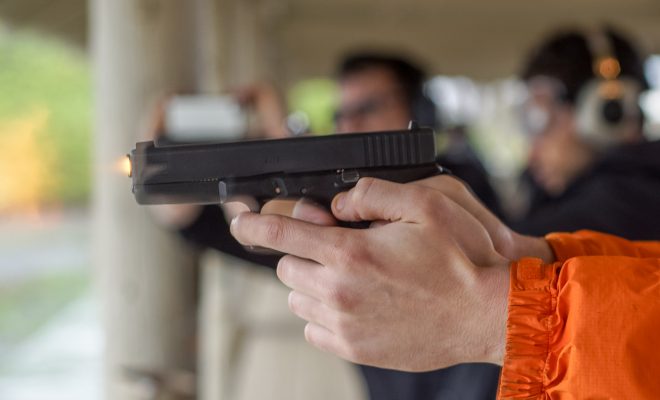 Image courtesy of [Peretz Partensky via Flickr]
Image courtesy of [Peretz Partensky via Flickr]
Law
America’s Focus on Guns by the Numbers
The recent shooting at the Emanuel A.M.E. Church in Charleston, South Carolina opened up a number of old wounds for the country and reinvigorated several dormant concerns that seem to linger in the American consciousness. Chief among these concerns is both racism and America’s lack of gun control laws. While many were quick to put the blame in this case on a twisted, racist individual, there were others who said it was just one more in the litany of examples of the side effects of a culture that enthusiastically embraces guns without any real checks. Read on to learn more about gun control in this country, the role of groups such as the National Rifle Association, and what impact this has on the lives of everyday Americans.
History of Gun Control
What does the Second Amendment actually mean?
Any and all issues concerning guns in the United States start with the Second Amendment. While people associate the amendment with protecting their right to own firearms, the exact wording is as follows: “A well-regulated Militia, being necessary to the security of a free State, the right of the people to keep and bear Arms, shall not be infringed.” The amendment was originally designed as a check against the federal government, in essence to protect the states from being overwhelmed by its standing army.
According to former Supreme Court Justice John Paul Stephens, over the years the law has been misinterpreted and manipulated for political gain. Originally it was designed so that people could bear arms as part of a militia in order to protect against the federal government. In other words, these people would own weapons as a function of their status within a militia. In fact, this was the way the law was interpreted for most of American history. But beginning in 2008, in a controversial Supreme Court decision regarding handguns, the amendment was interpreted to owning guns in general, instead of for a purpose. On top of this, the type of weapons protected also expanded. Specifically, in 1939 in a famous case cited by Stephens, sawed-off shotguns were ruled illegal because they did not fit the requirement of self-protection that was originally interpreted as the law’s modus operandi. However, as recent efforts have shown in which automatic weapons have become allowable these same rules no longer apply.
Failed Efforts at Reform
While gun control advocates are seemingly losing the battle over gun ownership in the U.S., this has not always been the case. On the contrary, the opposite held true for much of America’s history. The first efforts at regulation were in 1934. Following the high number of deaths resulting from the use of automatic weapons by prohibition-era gangsters, the federal government passed the National Firearms Act, which both made automatic weapons too expensive for the average person to afford and prevented the importation of the weapons.
The Gun Control Act was passed in 1968, in the aftermath of the high-profile killings of Martin Luther King Jr. and Robert Kennedy. This legislation created the Bureau of Alcohol, Tobacco and Firearms (ATF). ATF was tasked with regulating the sale of guns and the weapons themselves.
The tide began to turn against gun control advocates, however, with the passage of the 1986 Firearm Owners’ Protection Act, which limited the ATF in its crackdown of gun owners and dealers. The gun control side had one last hurrah with the Brady Act in 1994, which outlawed the sale of assault weapons. This law nevertheless had a built-in sunset provision of ten years. When it came up for reauthorization in 2004 it was not renewed.
Along with the recent court decisions supporting gun ownership rights, the country’s representatives also seem to be opposed to regulating the weaponry. This became clear in the wake of the Sandy Hook massacre when both new legislation and efforts to expand existing legislation, which called for background checks, failed to gain traction even in the shadow of the massacre of 20 elementary school children. Click here to view a video explainer on the history of gun control in the United States.
Guns in America
An Abundance of Firearms
Despite all the discussion over protecting gun owners’ rights, only a minority of the population actually owns any guns at all. While exact figures do not exist, according to a 2013 survey by the Pew Research Center, only about 37 percent of Americans own firearms. However, while less than half of the U.S. owns a gun, there are an estimated 270 to 310 million in circulation among the civilian population. In other words, one for every man, woman, and child. To put this into context, although the U.S. accounts for only about five percent of the world’s population, it is home to between 35 to 50 percent of its firearms. While the overwhelming majority of these are owned by law-abiding citizens, the sheer volume of available weapons has led to a serious issue with gun violence in the United States. The following video depicts the level of gun ownership, gun fatalities, and attempts at gun control.
Gun Deaths by the Numbers
While those who favor protecting gun rights over gun control cite protection as a main reason, it has to be asked, are guns making the U.S. any safer? Going strictly by numbers and in comparison to other industrialized nations, the answer is a resounding no. On an average day in the U.S., 88 people die from a gun-related incident. The yearly total extrapolates to roughly 32, 251, the approximate figure in 2011 according to the CDC.
These rates dwarf those of countries in Western Europe to which the United States is often compared in other metrics. The U.S. in 2010 for example had a homicide rate that was 6.6 times higher than that of Portugal, who had the highest rate in Western Europe. To put it another way, that same year the U.S. had a higher homicide rate per capita than Pakistan, a country renowned for terrorism, and was only slightly behind other nefarious locales such as the Democratic Republic of Congo and Iraq. Perhaps the most chilling comparison is the 2013 numbers which show major American cities with homicide rates similar to that of notoriously violent countries such as El Salvador, Honduras, and Mexico. While it should be made clear that all gun-related deaths in the U.S. are not homicides, the fact that these are also some of the highest figures in the world is telling in itself.
The level of gun violence is so high in the United States that Surgeon General Vivek Murthy argued prior to being appointed to the position in 2014 that it is a public health crisis.
In defense of guns, some proponents compare them to automobile fatalities and suggest that no one ever considers banning cars. This comparison may soon be losing traction, however. Not even taking into account factors such as cars being used for longer time periods and much more frequently than firearms, overall vehicle fatalities are declining. In fact, while gun deaths continue to rise, projections for automobile deaths continue to fall and it is widely speculated that gun-related fatalities will soon eclipse those from automobiles.
Opinions of Guns
With all this in mind, what is the perception of gun control and gun ownership in this country today? According to a recent Pew Research Poll, for the first time since polling began in the early 1990s, more people view protecting gun rights as important than they do controlling gun ownership. The main motivation behind this is a perceived threat and belief in an increased crime rate. However, crime rates have remained consistently low since the beginning of their precipitous fall in the early 1990s.
Nonetheless, the main reason why those polled owned guns was for protection. This is in stark contrast to just 16 years ago when the main reason given by respondents was hunting. These numbers can be broken down further; white people, men, and those who identify as Republican are also more in favor of protecting gun ownership rights and believe guns are a means of protection that makes a home safer.
The fact that support for gun ownership is going up as crime rates remain low presents a paradox. The perception then according to these polls is people are either being misinformed or misinterpreting the issues relating to gun ownership.
The NRA
The National Rifle Association (NRA) has a major impact on the perception of firearms in the United States. In 2014 for example, the NRA donated $984,152 in political contributions, spent $3.36 million on lobbying, and another $28.2 million on outside spending. Nevertheless, while this may seem like a lot, the organization ranked 315 in contributions, 150 in lobbying, and 10 in outside spending among all groups.
Thus, the NRA seemingly has far more clout than is warranted based on how much money it spends. From where then does its power come? The answer is in the rating system the NRA has for candidates. The system provides a letter grade, similar to one from elementary school, based on how a candidate votes on a bill related to guns. An A-grade indicates a candidate’s strong adherence to individual gun ownership and conservative values.
Watch the video below for more information about the NRA.
Conclusion
The United States is a heavily weaponized country, in fact the most heavily weaponized in the world. This extends from its military, which is the best funded by far, to its police forces, which are quickly resembling its military in terms of equipment. This has even pervaded the towns, communities, and neighborhoods as regular Americans are armed like no other people on the globe.
This is the result of years of lobbying by pro-gun groups, namely the NRA, and decisions by the government and courts to protect gun ownership. Subsequently, the widespread availability of these weapons has also led to extremely high numbers of gun-related deaths and homicide rates that on average rival some of the most dangerous countries in the world.
While these facts have caused some to take pause, they have not led to any real change in regulating these weapons, whether this takes the form of outlawing guns in general or requiring more thorough background checks for the mentally ill. The numbers on this issue are unquestionable. The debate, however, on how to handle this issue is still wide open to a variety of corrective actions.
Regardless though, the recent events in Charleston showed that whether it is guns themselves or those wielding the weapons, they have contributed to immense suffering and loss in this country. Whether protecting the right to own these weapons supersedes these individual tragedies is where the debate now begins.
Resources
Atlantic: America’s Top Killing Machines
Economist: Why Gun Control is Doomed
Washington Post: The Five Extra Words That Can Fix the Second Amendment
Pew Research Center: A Minority of Americans Own Guns, But Just How Many is Unclear
Humano Sphere: Visualizing Gun Deaths
National Journal: Senate Confirms Gun Control Advocate as Surgeon General
Pew Research Center: Despite Lower Crime Rates, Support For Gun Rights Increases
Pew Research Center: Why Own a Gun? Protection is Now Top Reason
Open Secrets: National Rifle Association
GQ: How the NRA’s Grading System Keeps Congress on Lockdown








Comments